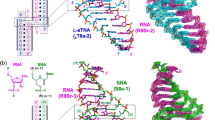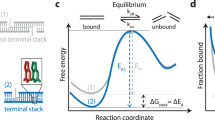Abstract
ONE of the most important problems in research on nucleic acid is the understanding of the forces which maintain the helical structure. After the elucidation of the double helix by Watson and Crick1, the helical secondary structure of DNA was thought to derive its stability from hydrogen bonding between the base pair. The discovery that polynucleotides could exist in single strand ordered helical conformation2–6 demonstrated that other types of forces are involved in the stability of this structure. These stacking forces between parallel bases were thought to be of the Van der Waals type. More recent work shows that the presence, absence or modification of the 2′ hydroxyl group plays an important part in the conformational stability of the oligo and poly-nucleotides7–12.
This is a preview of subscription content, access via your institution
Access options
Subscribe to this journal
Receive 51 print issues and online access
$199.00 per year
only $3.90 per issue
Buy this article
- Purchase on SpringerLink
- Instant access to full article PDF
Prices may be subject to local taxes which are calculated during checkout
Similar content being viewed by others
References
Watson, J. D., and Crick, F. H. C., Nature, 171, 737 (1953).
Brahms, J., J. Amer. Chem. Soc., 85, 3298 (1963).
Fasman, G. D., Lindblow, C., and Grossmann, L., Biochemistry, 3, 1015 (1964).
Luzzati, V., Mathis, A., Masson, F., and Witz, J., J. Mol. Biol., 10, 28 (1964).
Holcomb, D. N., and, Tinoco, jun., I., Biopolymers, 3, 121 (1965).
Van Holde, K. E., Brahms, J., and Michelson, A. M., J. Mol. Biol., 12, 726 (1965).
Brahms, J., Maurizot, J. C., and Michelson, A. M., J. Mol. Biol., 25, 481 (1967).
Adler, A., Grossmann, L., and Fasman, G. D., Proc. US Nat. Acad. Sci., 57, 423 (1967).
Vournakis, J., Poland, D., and Scheraga, H. A., Biopolymers, 5, 403 (1967).
Ts'O, P. O. P., Rapaport, S. A., and Bollum, F. J., Biochemistry, 5, 4153 (1966).
Maurizot, J. C., Wechter, W. J., Brahms, J., and Sadron, Ch., Nature, 219, 377 (1968).
Adler, A. J., Grossmann, L., and Fasman, G. D., Biochemistry, 7, 3836 (1968).
Brahms, J., Michelson, A. M., and Van Holde, K. E., J. Mol. Biol., 15, 467 (1966).
Poland, D., Vournakis, J. N., and Scheraga, H. A., Biopolymers, 4, 223 (1966).
Davis, R. C., and Tinoco, jun., I., Biopolymers, 6, 223 (1968).
Author information
Authors and Affiliations
Rights and permissions
About this article
Cite this article
MAURIZOT, J., BRAHMS, J. & ECKSTEIN, F. Forces involved in the Conformational Stability of Nucleic Acids. Nature 222, 559–561 (1969). https://doi.org/10.1038/222559a0
Received:
Issue date:
DOI: https://doi.org/10.1038/222559a0
This article is cited by
-
Hydratation und Sekundärstruktur doppelhelikaler synthetischer Polynukleotide
Experientia (1971)
-
The stabilisation of nucleic acid structures
Biophysik (1970)



